Nunavut
Nunavut | |
|---|---|
| Country | Canada |
| Confederation | April 1, 1999 (13th) |
| Government | |
| • Commissioner | Nellie Kusugak |
| • Premier | Peter Taptuna |
| Legislature | Legislative Assembly of Nunavut |
| Federal representation | Parliament of Canada |
| House seats | 1 of 338 (0.3%) |
| Senate seats | 1 of 105 (1%) |
| Population | |
| • Total | 36,858 |
| GDP | |
| • Rank | 13th |
| • Total (2011) | C$1.964 billion[2] |
| • Per capita | C$58,452 (6th) |
| Canadian postal abbr. | NU |
| Postal code prefix | |
| Rankings include all provinces and territories | |
Template:Contains Canadian text
Nunavut (/ˈnuːnəˌvʊt/; from Inuktitut: ᓄᓇᕗᑦ [ˈnunavut]) is the newest, largest, northernmost, and least populous territory of Canada. It was separated officially from the Northwest Territories on April 1, 1999, via the Nunavut Act[3] and the Nunavut Land Claims Agreement Act,[4] though the boundaries had been contemplatively drawn in 1993. The creation of Nunavut resulted in the first major change to Canada's political map since the incorporation of the new province of Newfoundland and Labrador in 1949.
Nunavut comprises a major portion of Northern Canada, and most of the Canadian Arctic Archipelago. Its vast territory makes it the fifth-largest country subdivision in the world, as well as the second-largest in North America (after Greenland). The capital Iqaluit (formerly "Frobisher Bay") on Baffin Island in the east, was chosen by the 1995 capital plebiscite. Other major communities include the regional centres of Rankin Inlet and Cambridge Bay. Nunavut also includes Ellesmere Island to the far north, as well as the eastern and southern portions of Victoria Island in the west and Akimiski Island in James Bay far to the southeast of the rest of the territory. It is the only geo-political region of Canada that is not connected to the rest of North America by highway.[5]
Nunavut is both the least populous and the largest in area of the provinces and territories of Canada. One of the most remote, sparsely settled regions in the world, it has a population of 31,906,[1] mostly Inuit, spread over a land area the size of Western Europe. Nunavut is also home to the northernmost permanently inhabited place in the world, Alert.[6] A weather station farther down Ellesmere Island, Eureka, has the lowest average annual temperature of any weather station in Canada.[7]
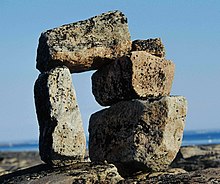
Etymology
Nunavut means "our land" in Inuktitut.
Geography
Nunavut covers 1,877,787 km2 (725,018 sq mi)[1] of land and 160,935 km2 (62,137 sq mi)[8] of water in Northern Canada. The territory includes part of the mainland, most of the Arctic Archipelago, and all of the islands in Hudson Bay, James Bay, and Ungava Bay (including the Belcher Islands), which belonged to the Northwest Territories. This makes it the fifth largest subnational entity (or administrative division) in the world. If Nunavut were a country, it would rank 15th in area.[9]
Nunavut has land borders with the Northwest Territories on several islands as well as the mainland, Manitoba to the south of the Nunavut mainland, Saskatchewan to the southwest (at a single four-corner point), and a small land border with Newfoundland and Labrador on Killiniq Island and with Ontario in two small locations in James Bay: the larger located west of Akimiski Island and the smaller around the Albany River near Fafard Island. It also shares maritime borders with Greenland and the provinces of Quebec, Ontario, and Manitoba.
Nunavut's highest point is Barbeau Peak (2,616 m (8,583 ft)) on Ellesmere Island. The population density is 0.015 persons per square kilometre, one of the lowest in the world. By comparison, Greenland has approximately the same area and nearly twice the population.[10]
Climate
Nunavut experiences a polar climate in most regions, owing to its high latitude.
| City | July (°C) | July (°F) | January (°C) | January (°F) |
|---|---|---|---|---|
| Alert | 6/1 | 43/33 | −29/−36 | −20/−33 |
| Baker Lake | 17/6 | 63/43 | −28/−35 | −18/−31 |
| Cambridge Bay | 13/5 | 55/41 | −29/−35 | −19/−32 |
| Eureka | 9/3 | 49/37 | −33/−40 | −27/−40 |
| Iqaluit | 12/4 | 54/39 | −23/−31 | −9/−24 |
| Kugluktuk | 16/6 | 60/43 | −23/−31 | −10/−25 |
| Rankin Inlet | 15/6 | 59/43 | −27/−34 | −17/−30 |
History
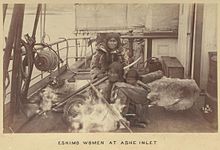
The region now known as Nunavut has supported a continuous indigenous population for approximately 4,000 years. Most historians identify the coast of Baffin Island with the Helluland described in Norse sagas, so it is possible that the inhabitants of the region had occasional contact with Norse sailors.
Archaeological findings
In September 2008, researchers reported on the evaluation of existing and newly excavated archaeological remains, including yarn spun from a hare, rats, tally sticks, a carved wooden face mask that depicts Caucasian features, and possible architectural material. The materials were collected in five seasons of excavation at Cape Tanfield. Scholars determined that these provide evidence of European traders and possibly settlers on Baffin Island, not later than 1000 CE (and thus older than or contemporaneous with L'Anse aux Meadows). They seem to indicate prolonged contact, possibly up to 1450. The origin of the Old World contact is unclear; the article states: "Dating of some yarn and other artifacts, presumed to be left by Vikings on Baffin Island, have produced an age that predates the Vikings by several hundred years. So [...] you have to consider the possibility that as remote as it may seem, these finds may represent evidence of contact with Europeans prior to the Vikings' arrival in Greenland."[12]

First written historical accounts
The written historical accounts of Nunavut begin in 1576, with an account by an English explorer Martin Frobisher, while leading an expedition to find the Northwest Passage, thought he had discovered gold ore around the body of water now known as Frobisher Bay on the coast of Baffin Island.[13] The ore turned out to be worthless, but Frobisher made the first recorded European contact with the Inuit. Other explorers in search of the elusive Northwest Passage followed in the 17th century, including Henry Hudson, William Baffin and Robert Bylot.
Cold War
Cornwallis and Ellesmere Islands featured in the history of the Cold War in the 1950s. Concerned about the area's strategic geopolitical position, the federal government relocated Inuit from Nunavik (northern Quebec) to Resolute and Grise Fiord. In the unfamiliar and hostile conditions, they faced starvation[14] but were forced to stay.[15] Forty years later, the Royal Commission on Aboriginal Peoples issued a report titled The High Arctic Relocation: A Report on the 1953–55 Relocation.[16] The government paid compensation to those affected and their descendants, but it did not apologize.[17]

Recent history
In 1976, as part of the land claims negotiations between the Inuit Tapiriit Kanatami (then called the "Inuit Tapirisat of Canada") and the federal government, the parties discussed division of the Northwest Territories to provide a separate territory for the Inuit. On April 14, 1982, a plebiscite on division was held throughout the Northwest Territories. A majority of the residents voted in favour and the federal government gave a conditional agreement seven months later.[18]
The land claims agreement was completed in September 1992 and ratified by nearly 85% of the voters in Nunavut in a referendum. On July 9, 1993, the Nunavut Land Claims Agreement Act[4] and the Nunavut Act[3] were passed by the Canadian Parliament. The transition to establish Nunavut Territory was completed on April 1, 1999.[19] The creation of Nunavut has been followed by growth in the capital, Iqaluit—a modest increase from 5,200 in 2001 to 6,600 in 2011.
Demography

As of the 2011 Census, the population of Nunavut was 31,906, an 8.3% increase from 2006.[1] In 2006, 24,640 people identified themselves as Inuit (83.6% of the total population), 100 as First Nations (0.34%), 130 Métis (0.44%) and 4,410 as non-aboriginal (14.96%).[20]
| Municipality | 2011 | 2006 | growth |
|---|---|---|---|
| Iqaluit | 6,699 | 6,184 | 8.3% |
| Rankin Inlet | 2,577[21] | 2,358 | 9.3% |
| Arviat | 2,318 | 2,060 | 12.5% |
| Baker Lake | 1,872 | 1,728 | 8.3% |
| Cambridge Bay | 1,608 | 1,477 | 8.9% |
| Pond Inlet | 1,549 | 1,315 | 17.8% |
| Igloolik | 1,454 | 1,538 | −5.5% |
| Kugluktuk | 1,450 | 1,302 | 11.4% |
| Pangnirtung | 1,425 | 1,325 | 7.5% |
| Cape Dorset | 1,363 | 1,236 | 10.3% |
The population growth rate of Nunavut has been well above the Canadian average for several decades, mostly due to birth rates significantly higher than the Canadian average—a trend that continues. Between April and July 2010, Nunavut had the highest population growth rate of any Canadian province or territory, at a rate of 1.01%.[22] The second highest was Yukon, with a growth rate of 0.90%. However, Nunavut has a large net loss from migration, due to many native Inuit leaving the territory for better economic opportunity elsewhere.
Language
Along with the Inuit language (Inuktitut and Inuinnaqtun), English and French are also official languages.[23]
In his 2000 commissioned report (Aajiiqatigiingniq Language of Instruction Research Paper) to the Nunavut Department of Education, Ian Martin of York University states that a "long-term threat to Inuit language from English is found everywhere, and current school language policies and practices on language are contributing to that threat" if Nunavut schools follow the Northwest Territories model. He provides a 20-year language plan to create a "fully functional bilingual society, in Inuktitut and English" by 2020. The plan provides different models, including:
- "Qulliq Model", for most Nunavut communities, with Inuktitut as the main language of instruction.
- "Inuinnaqtun Immersion Model", for language reclamation and immersion to revitalize Inuinnaqtun as a living language.

- "Mixed Population Model", mainly for Iqaluit (possibly for Rankin Inlet), as the 40% Qallunaat, or non-Inuit, population may have different requirements.[24]

Of the 29,025 responses to the census question concerning 'mother tongue', the most commonly reported languages were:
| 1. | Inuktitut | 20,185 | 69.54% |
| 2. | English | 7,765 | 26.75% |
| 3. | French | 370 | 1.27% |
| 4. | Inuinnaqtun | 295 | 1.02% |
Only English and French were counted as official languages in the census. Nunavut's official languages are shown in bold. Figures shown are for the number of single-language responses and the percentage of total single-language responses.[25]
In the 2006 census it was reported that 2,305 people (7.86%) living in Nunavut had no knowledge of either official language of Canada (English or French).[26]
Religion
The largest denominations by number of adherents according to the 2001 census were the Anglican Church of Canada with 15,440 (58%); the Roman Catholic Church (Roman Catholic Diocese of Churchill-Baie d'Hudson) with 6,205 (23%); and Pentecostal with 1,175 (4%).[27] In total, 93.2% of the population were Christian.
Economy
The economy of Nunavut is Inuit and Territorial Government, mining, oil gas mineral exploration, arts crafts, hunting, fishing, whaling, tourism, transportation, education - Nunavut Arctic College, housing, military and research – new Canadian High Arctic Research Station CHARS in planning for Cambridge Bay and high north Alert Bay Station. Iqaluit hosts the annual Nunavut Mining Symposium every April, this is a tradeshow that showcases many economic activities on going in Nunavut.
Mining and exploration
There are currently two mines in operation in Nunavut. Agnico-Eagle Mines Ltd – Meadowbank Division. Meadowbank is an open pit gold mine with an estimated mine life 2010–2018 and employs 678 persons. Cost to produce an ounce of gold is $913.00[28] The north holds vast reserves of coal, oil, and gas and, increasingly, these areas are being looked at to move into production.
The other mine in production is the Mary River Iron Ore mine operated by Baffinland Iron Mines. It is located close to Pond Inlet on North Baffin Island. They produce a high grade direct ship iron ore.
Advancing mining projects
| Name | Company | In the region of | Material |
|---|---|---|---|
| Meliadine Gold | Agnico-Eagle | Rankin Inlet | Gold |
| Back River Project | Sabina Gold & Silver Corp. | Bathurst Inlet | Gold |
| Izok Corridor Project | MMG Resources Inc. | Kugluktuk | Gold, Copper, Silver, Zinc |
| Hackett River | Glencore | Kugluktuk | Copper, Lead, Silver, Zinc |
| Chidliak | Peregrine Diamonds Ltd. | Iqaluit / Pangnirtung | Diamonds |
| Committee Bay, Three Bluffs Gold Project | Auryn Resources Inc | Naujaat | Gold |
| Kiggavik | Areva Resources | Baker Lake | Uranium |
| Hope Bay Doris North Mine | TMAC Resources Inc | Cambridge Bay | Gold |
| Roche Bay | Advanced Exploration | Hall Beach | Iron Ore |
| Ulu and Lupin | Elgin Mining Ltd. | Contwoyto Lake - connected to Yellowknife with an ice road | Gold |
| Storm Copper Property | Aston Bay Holdings | Taloyoak | Copper |
Historic mines
- Lupin Mine 1982–2005, gold, current owner Elgin Mining Ltd located near the Northwest Territories boundary near Contwoyto Lake)[29]
- Polaris Mine 1982–2002, lead and zinc (located on Little Cornwallis Island, not far from Resolute)
- Nanisivik Mine 1976–2002, lead and zinc, prior owner Breakwater Resources Ltd (near Arctic Bay) at Nanisivik
- Rankin Nickel Mine 1957–1962, nickel, copper and platinum group metals
- Jericho Diamond Mine 2006–2008, diamond (located 400 km, 250 mi, northeast of Yellowknife) 2012 produced diamonds from existing stockpile. No new mining; closed.
- Doris North Gold Mine Newmont Mining approx 3 km underground drifting/mining, none milled or processed. Newmont closed the mine and sold it to TMAC Resources in 2013. TMAC is now advancing this project.
Transportation
- Northern Transportation Company Limited, owned by Norterra, a holding company that was, until April 1, 2014, jointly owned by the Inuvialuit of the Northwest Territories and the Inuit of Nunavut.[30][31][32][33]
Renewable power
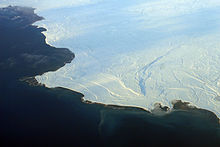
Currently the people of Nunavut rely primarily on diesel fuel[34] to run generators and heat homes, with fossil fuel shipments coming from southern Canada by plane or boat because there are few to no roads or rail links to the region.[35] There is a government effort to use more renewable energy sources,[36] which is generally supported by the community.[37]
This support comes from Nunavut feeling the effects of global warming.[38][39] Former Nunavut Premier Eva Aariak said in 2011, "Climate change is very much upon us. It is affecting our hunters, the animals, the thinning of the ice is a big concern, as well as erosion from permafrost melting."[35] The region is warming about twice as fast as the global average, according to the UN's Intergovernmental Panel on Climate Change.
Government and politics
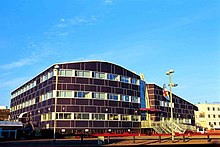
Nunavut has a Commissioner appointed by the federal Minister of Indigenous and Northern Affairs. As in the other territories, the commissioner's role is symbolic and is analogous to that of a Lieutenant-Governor. While the Commissioner is not formally a representative of Canada's head of state, a role roughly analogous to representing The Crown has accrued to the position.
Nunavut elects a single member of the Canadian House of Commons. This makes Nunavut the largest parliamentary riding in the world by area.
The members of the unicameral Legislative Assembly of Nunavut are elected individually; there are no parties and the legislature is consensus-based.[40] The head of government, the premier of Nunavut, is elected by, and from the members of the legislative assembly. As of January 21, 2014, the Premier is Peter Taptuna.
Faced by criticism of his policies, former Premier Paul Okalik set up an advisory council of eleven elders, whose function it is to help incorporate "Inuit Qaujimajatuqangit" (Inuit culture and traditional knowledge, often referred to in English as "IQ") into the territory's political and governmental decisions.[citation needed]

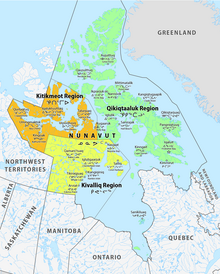
Owing to Nunavut's vast size, the stated goal of the territorial government has been to decentralize governance beyond the region's capital. Three regions—Kitikmeot, Kivalliq and Qikiqtaaluk/Baffin—are the basis for more localized administration, although they lack autonomous governments of their own.[citation needed]
The territory has an annual budget of C$700 million, provided almost entirely by the federal government. Former Prime Minister Paul Martin designated support for Northern Canada as one of his priorities for 2004, with an extra $500 million to be divided among the three territories.[citation needed]
In 2001, the government of New Brunswick[citation needed] collaborated with the federal government and the technology firm SSI Micro to launch Qiniq, a unique network that uses satellite delivery to provide broadband Internet access to 24 communities in Nunavut. As a result, the territory was named one of the world's "Smart 25 Communities" in 2006 by the Intelligent Community Forum, a worldwide organization that honours innovation in broadband technologies. The Nunavut Public Library Services, the public library system serving the territory, also provides various information services to the territory.
In September 2012, Premier Aariak welcomed Prince Edward and Sophie, Countess of Wessex, to Nunavut as part of the events marking the Diamond Jubilee of Queen Elizabeth II.[41]
Licence plates
The Nunavut licence plate was originally created for the Northwest Territories in the 1970s. The plate has long been famous worldwide for its unique design in the shape of a polar bear. Nunavut was licensed by the NWT to use the same licence plate design in 1999 when it became a separate territory,[42] but adopted its own plate design in March 2012 for launch in August 2012—a rectangle that prominently features the northern lights, a polar bear and an inuksuk.[42][43]
Flag and coat of arms
The flag and the coat of arms of Nunavut were designed by Andrew Karpik from Pangnirtung.[44]
Culture
Music

The indigenous music of Nunavut includes Inuit throat singing and drum-led dancing, along with country music, bluegrass, square dancing, the button accordion and the fiddle, an infusion of European influence.
Media
The Inuit Broadcasting Corporation is based in Nunavut. The Canadian Broadcasting Corporation (CBC) serves Nunavut through a radio and television production centre in Iqaluit, and a bureau in Rankin Inlet. The territory is also served by two regional weekly newspapers Nunatsiaq News published by Nortext and Nunavut News/North, published by Northern News Services, who also publish the regional Kivalliq News.[45] Broadband internet is provided by Qiniq and Northwestel through Netkaster.[46][47]
Film
The film production company Isuma is based in Igloolik. Co-founded by Zacharias Kunuk and Norman Cohn in 1990, the company produced the 1999 feature Atanarjuat, winner of the Caméra d'Or for Best First Feature Film at the 2001 Cannes Film Festival. It was the first feature film written, directed, and acted entirely in Inuktitut.
In November 2006, the National Film Board of Canada (NFB) and the Inuit Broadcasting Corporation announced the start of the Nunavut Animation Lab, offering animation training to Nunavut artists at workshops in Iqaluit, Cape Dorset and Pangnirtung.[48] Films from the Nunavut Animation Lab include Alethea Arnaquq-Baril's 2010 digital animation short Lumaajuuq, winner of the Best Aboriginal Award at the Golden Sheaf Awards and named Best Canadian Short Drama at the imagineNATIVE Film + Media Arts Festival.[49]
In November 2011, the government of Nunavut and the NFB jointly announced the launch of a DVD and online collection entitled Unikkausivut (Inuktitut: Sharing Our Stories), which will make over 100 NFB films by and about Inuit available in Inuktitut, Inuinnaqtun and other Inuit languages, as well as English and French. The Government of Nunavut is distributing Unikkausivut to every school in the territory.[50][51]
Performing arts
Artcirq is a collective of Inuit circus performers based in Igloolik.[52] The group has performed around the world, including at the 2010 Olympic Winter Games in Vancouver, British Columbia.
Nunavummiut (notable people)
Susan Aglukark is an Inuit singer and songwriter. She has released six albums and has won several Juno Awards. She blends the Inuktitut and English languages with contemporary pop music arrangements to tell the stories of her people, the Inuit of Arctic.
On May 3, 2008, the Kronos Quartet premiered a collaborative piece with Inuit throat singer Tanya Tagaq, entitled Nunavut, based on an Inuit folk story. Tagaq is also known internationally for her collaborations with Icelandic pop star Björk.
Jordin John Kudluk Tootoo (Inuktitut syllabics: ᔪᐊᑕᓐ ᑐᑐ; born February 2, 1983 in Churchill, Manitoba, Canada) is a professional ice hockey player with the New Jersey Devils of the National Hockey League (NHL). Although born in Manitoba, Tootoo grew up in Rankin Inlet, where he was taught to skate and play hockey by his father, Barney.
Alcohol
Due to prohibition laws influenced by local and traditional beliefs, the territory of Nunavut has a highly regulated alcohol market. It is the last outpost of prohibition in Canada, and it is often easier to obtain firearms than it is to obtain alcohol.[53] Every community in Nunavut has slightly differing regulations regarding alcohol, but as a whole it is still very restrictive. In total, 7 communities have bans against alcohol and another 14 have orders being restricted by local committees. Because of these laws, a very lucrative bootlegging market has appeared where people mark up the prices of bottles by extraordinary amounts.[54] Despite the bans and restrictions, alcohol has found its way into the hands of many people and leading to widespread alcohol related crime. One lawyer estimated that some 95% of police calls are alcohol related.[55] The RCMP estimate that the bootleg liquor market in Nunavut rakes in some $10 million a year.[53] Alcohol is also believed to be a contributing factor to the high rates of violence, suicide and homicide in the territory. A special task force was created in 2010 to study and deal with the increasing problems related to alcohol in Nunavut, and when reconvened, recommended the government to ease up on alcohol restrictions. With prohibition shown to be highly ineffective historically, it is believed these laws are the ones contributing to the widespread social ills that the territory has experienced. However, many residents are still skeptical about the effectiveness of liquor sale liberalization and wish to ban it completely. In 2014, the government of Nunavut decided to move towards more legalization. A liquor store will be opened in Iqaluit, the capital, for the first time in 38 years.[53]
See also
- Chemetco, U.S. company that produced air-borne dioxin inferred to be the source of contamination in Nunavut
- Archaeology in Nunavut
- Scouting and Guiding in Nunavut
- Symbols of Nunavut
- Arctic policy of Canada
Footnotes
^1 Effective November 12, 2008.
References
- ^ a b c d e "Census Profile Nunavut". Statistics Canada. June 28, 2010. Retrieved February 9, 2012.
- ^ "Gross domestic product, expenditure-based, by province and territory (2011)". Statistics Canada. November 19, 2013. Retrieved September 26, 2013.
- ^ a b Justice Canada (1993). "Nunavut Act". Retrieved April 26, 2007.
- ^ a b Justice Canada (1993). "Nunavut Land Claims Agreement Act". Retrieved April 26, 2007.
- ^ "How to Get Here". Nunavut Tourism. Retrieved June 22, 2014.
- ^ Canadian Forces Station Alert
- ^ "Cold Places in Canada". The Canadian Encyclopedia. Retrieved March 12, 2013.
- ^ "Nunavut".
- ^ See List of countries and outlying territories by total area
- ^ "CIA World Factbook". CIA. Retrieved February 16, 2011.
- ^ "Nunavut Alert - Whale Cove" (CSV (4222 KB)). Canadian Climate Normals 1981–2010. Environment Canada. Climate ID: 2300MKF. Retrieved November 27, 2013.
- ^ Jane George, "Kimmirut site suggests early European contact: Hare fur yarn, wooden tally sticks may mean visitors arrived 1,000 years ago", Nunatsiaq News, September 12, 2008. Retrieved October 5, 2009
- ^ "Nunavut: The Story of Canada's Inuit People", Maple Leaf Web
- ^ "Grise Fiord: History".
- ^ McGrath, Melanie. The Long Exile: A Tale of Inuit Betrayal and Survival in the High Arctic. Alfred A. Knopf, 2006 (268 pages) Hardcover: ISBN 0-00-715796-7 Paperback: ISBN 0-00-715797-5
- ^ René Dussault and George Erasmus (1994). "The High Arctic Relocation: A Report on the 1953–55 Relocation". Royal Commission on Aboriginal Peoples, Toronto: Canadian Government Publishing. fedpubs.com.
- ^ Royte, Elizabeth (April 8, 2007). "Trail of Tears (review of Melanie McGrath, The Long Exile: A Tale of Inuit Betrayal and Survival in the High Arctic (2006)". The New York Times.
- ^ Peter Jull (Summer 1988). "Building Nunavut: A Story of Inuit Self-Government". The Northern Review. Yukon College. pp. 59–72. Retrieved February 16, 2009.
- ^ "Creation of Nunavut". CBC News. 2006. Retrieved April 26, 2007.
- ^ Statistics Canada (2006). "2006 Census Aboriginal Population Profiles". Retrieved January 16, 2008.
- ^ "Corrections and updates". Statistics Canada. August 13, 2013. Retrieved January 10, 2014.
- ^ "StatsUpdate". Prepared by Nunavut Bureau of Statistics. September 29, 2010. Retrieved November 20, 2010.
- ^ Consolidation of (S.Nu. 2008,c.10) (NIF) Official Languages Act and Consolidation of Inuit Language Protection Act
- ^ Board of Education (2000). "Summary of Aajiiqatigiingniq" (PDF). gov.nu.ca. Archived from the original (PDF) on October 15, 2007. Retrieved October 27, 2007.
{{cite journal}}: Cite journal requires|journal=(help) - ^ "Detailed Mother Tongue (186), Knowledge of Official Languages (5), Age Groups (17A) (3) (2006 Census)". 2.statcan.ca. December 7, 2010. Retrieved February 16, 2011.
- ^ Population by knowledge of official language, by province and territory (2006 Census). Statistics Canada. Retrieved January 15, 2010.
- ^ "Selected Religions, for Canada, Provinces and Territories – 20% Sample Data". 2.statcan.ca. Retrieved February 16, 2011.
- ^ "Meadowbank". Agnico Eagle.
- ^ "Wolfden Resources". Wolfden Resources. August 31, 2007. Retrieved February 16, 2011.
- ^ The NorTerra Group of Companies, corporate website
- ^ Northern Transportation Company Limited at NorTerra, corporate website
- ^ "Nunasi Corp. sells its stake in NorTerra, Canadian North". April 1, 2014.
- ^ "NunatsiaqOnline 2014-04-01: NEWS: Nunasi Corp. sells its half of Norterra to the Inuvialuit".
- ^ "Canada's North struggles to ditch diesel". Alberta Oil Magazine – Canada's leading source for oil and gas news.
- ^ a b Van Loon, Jeremy (December 7, 2011). "Nunavut Region to Boost Renewable Power to Offset Climate Change". Bloomberg.
- ^ McDonald, N.C.; J.M. Pearce (2012). "Renewable Energy Policies and Programs in Nunavut: Perspectives from the Federal and Territorial Governments". Arctic. 65 (4): 465–475. doi:10.14430/arctic4244.
- ^ Nicole C. McDonald & Joshua M. Pearce, "Community Voices: Perspectives on Renewable Energy in Nunavut", Arctic 66(1), pp. 94–104 (2013).
- ^ Nunavut and Climate Change, Aboriginal Affairs and Northern Development Canada
- ^ "Climate Change FAQ". Climate Change Nunavut.
- ^ CBC Digital Archives (2006). "On the Nunavut Campaign Trail". CBC News. Retrieved April 26, 2007.
- ^ "Sophie Wessex pays sartorial tribute to her Canadian hosts". Hello magazine. September 13, 2012.
- ^ a b Sarah Rogers (March 6, 2012). "GN launches new license plate". Nunatsiaq Online.
- ^ "Nunavut licence plates 1999–present". 15q.net. Retrieved February 16, 2011.
- ^ "Facts about Nunavut: About the Flag and Coat of Arms". Archived from the original on March 7, 2013.
{{cite web}}: Unknown parameter|deadurl=ignored (|url-status=suggested) (help) - ^ "Newspapers in Nunavut". Altstuff.com. Retrieved November 10, 2011.
- ^ "Qiniq". Qiniq. Retrieved November 10, 2011.
- ^ "Netkaster". Netkaster.ca. Retrieved November 10, 2011.
- ^ George, Jane (November 3, 2006). "Nunavut's getting animated". Nunatsiaq News. Retrieved November 8, 2011.
- ^ "Nunavut Animation Lab: Lumaajuuq". Collection. National Film Board of Canada. Retrieved November 8, 2011.
- ^ "Inuit films move online and into northern communities". CBC News. November 2, 2011. Retrieved November 5, 2011.
- ^ "New NFB collection includes 24 films on or by Inuit". Nunatsiaq News. November 4, 2011. Retrieved November 7, 2011.
- ^ "Bringing circus – and new hope – to a remote Arctic village". Christian Science Monitor. Retrieved December 28, 2009.
- ^ a b c "Iqaluit hopes to curb alcoholism and binge-drinking by opening city's first beer store in 38 years". National Post. Retrieved November 23, 2015.
- ^ https://www.youtube.com/watch?v=BIhUhHbTJ_s, retrieved November 23, 2015
{{citation}}: Missing or empty|title=(help) - ^ Communications, Government of Canada, Department of Justice, Electronic. "Department of Justice - Legal Aid, Courtworker, and Public Legal Education and Information Needs in the Northwest Territories". www.justice.gc.ca. Retrieved November 23, 2015.
{{cite web}}: CS1 maint: multiple names: authors list (link)
Further reading
- Alia, Valerie. (2007) Names and Nunavut Culture and Identity in Arctic Canada. New York: Berghahn Books. ISBN 1-84545-165-1
- Henderson, Ailsa. (2007) Nunavut: Rethinking Political Culture. Vancouver: University of British Columbia Press. ISBN 0-7748-1423-3
- Dahl, Jens; Hicks, Jack; Jull, Peter, eds. (2002), Nunavut: Inuit regain control of their lands and their lives, International Work Group for Indigenous Affairs, ISBN 87-90730-34-8
- Kulchyski, Peter Keith. (2005) Like the Sound of a Drum: Aboriginal Cultural Politics in Denendeh and Nunavut. Winnipeg: University of Manitoba Press. ISBN 0-88755-178-5
- Sanna, Ellyn, and William Hunter. (2008) Canada's Modern-Day Aboriginal Peoples Nunavut & Evolving Relationships. Markham, Ont: Scholastic Canada. ISBN 978-0-7791-7322-8
External links
- Nunavut Kavamat / Government of Nunavut: Official site
- Template:Dmoz
- Map showing regions of Nunavut (from Nunavut Government website)[dead link]
- Legislative Assembly of Nunavut
- Nunavut Planning Commission
- Annual Nunavut Mining Symposium held in April each year
- Nunavut Tunngavik Inc.: Nunavut Land Claims website
- The Nunavut Act of 1993 at Canadian Legal Information Institute
- Archived 2006-09-26 at the Wayback Machine: Martin, Ian. Aajiiqatigiingniq Language of Instruction Research Paper. Nunavut: Dept. of Education, 2000.[dead link]
Tourism
Journalism
- CBC North Radio: hear Inuktitut and English radio from Nunavut
- Territorial newspaper reporting in Inuktitut and English, Nunatsiaq News
- Nunavut News from News/North
